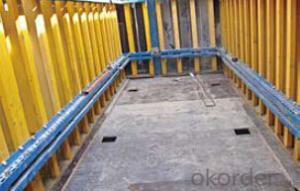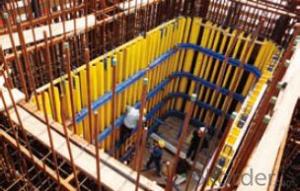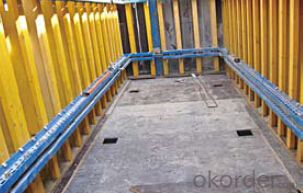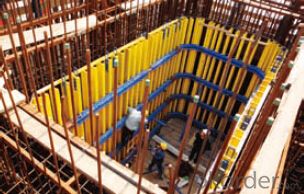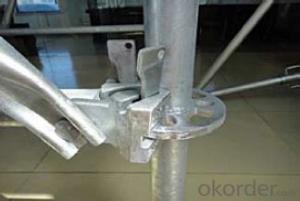Shaft platform S40 System for Formwork and Scaffolding
- Loading Port:
- Tianjin
- Payment Terms:
- TT OR LC
- Min Order Qty:
- 50 m²
- Supply Capability:
- 1000 m²/month
OKorder Service Pledge
Quality Product, Order Online Tracking, Timely Delivery
OKorder Financial Service
Credit Rating, Credit Services, Credit Purchasing
You Might Also Like
Shaft Platform
As operating platform, the shaft platform is mainly used in the concrete pouring of elevator shaft,
equipment shaft, stair shaft of high-rise building and so on.
Characteristics:
◆ The length of shaft beam is adjustable.
◆ Flexible structure makes lifting easier.
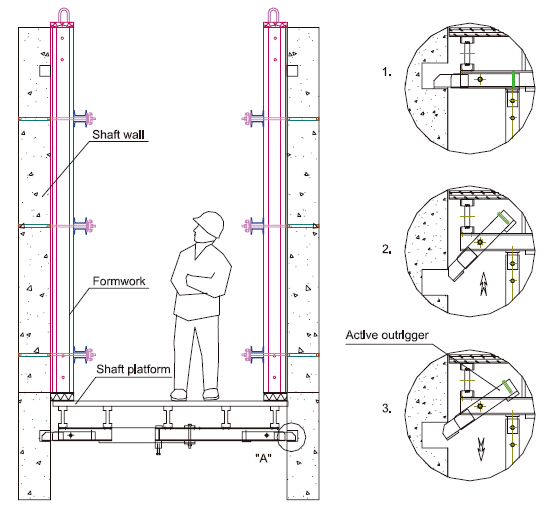
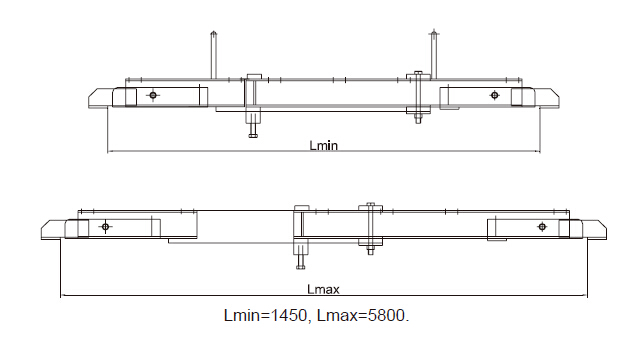
- Q: Can steel formwork be used for dam construction?
- Yes, steel formwork can be used for dam construction. Steel formwork is strong, durable, and can withstand the high pressure exerted by the water in dams. It provides a stable and secure framework for pouring concrete and ensuring the structural integrity of the dam. Additionally, steel formwork can be reused multiple times, making it a cost-effective choice for dam construction projects.
- Q: Are there any regulations or standards that govern the use of steel formwork?
- Yes, there are regulations and standards that govern the use of steel formwork in construction. These regulations ensure the safety, quality, and performance of steel formwork systems. Some widely recognized standards include the American Concrete Institute (ACI) 347-04 and the Occupational Safety and Health Administration (OSHA) regulations. These standards provide guidance on design, installation, inspection, and maintenance of steel formwork to ensure its proper and safe use in construction projects.
- Q: How does steel formwork affect the overall sound insulation of a building?
- Steel formwork does not directly affect the overall sound insulation of a building. Sound insulation primarily depends on the quality and design of the walls, floors, and ceilings, which are independent of the formwork material. However, steel formwork may indirectly impact sound insulation during the construction phase. Steel formwork is known for its rigidity and strength, which helps in ensuring accurate and precise concrete pouring. This precise construction technique can minimize the gaps and imperfections that may occur during the casting of concrete. As a result, steel formwork can contribute to creating a smoother and more uniform concrete surface, reducing the chances of sound leakage through cracks or joints. Furthermore, steel formwork can be used to create smooth and even surfaces, which can facilitate the installation of soundproofing materials such as acoustic panels or insulation. These additional soundproofing measures, when incorporated during the construction phase, can enhance the overall sound insulation of the building. It's important to note that while steel formwork can indirectly influence sound insulation during construction, the primary factors affecting sound insulation are the materials and techniques used for constructing walls, floors, and ceilings. Architectural design, insulation materials, and sealing techniques play a crucial role in achieving optimal sound insulation levels.
- Q: Are there any specific considerations for using steel formwork in areas with high seismic activity?
- Yes, there are several specific considerations for using steel formwork in areas with high seismic activity. Firstly, the steel formwork needs to be designed and constructed to withstand the seismic forces that occur during an earthquake. This includes ensuring that the formwork is adequately braced and anchored to prevent collapse or movement. Additionally, the connections between the different formwork elements should be strong and flexible enough to accommodate the seismic movements without compromising the overall stability of the structure. Furthermore, the selection of materials for the steel formwork should be appropriate for the seismic conditions, considering factors like strength, ductility, and corrosion resistance. Overall, proper design, construction, and material selection are crucial when using steel formwork in areas with high seismic activity to ensure the safety and integrity of the structure.
- Q: How does steel formwork contribute to the overall stability of a structure?
- The construction industry greatly relies on steel formwork to ensure the stability of structures. This crucial component is extensively used for casting concrete elements like walls, slabs, columns, and beams. Steel formwork enhances stability by providing a rigid and robust framework for pouring and setting concrete. The steel panels and frames are designed to withstand the pressure exerted by wet concrete, preventing deformation during the curing process. This prevents any potential structural deficiencies or unevenness that may compromise stability. Moreover, steel formwork offers exceptional strength and durability, making it suitable for various construction projects. Its high tensile strength enables it to bear heavy loads, which is especially important for large-scale structures. Additionally, the formwork's strength allows for multiple reuses, reducing construction costs and environmental impact. Furthermore, steel formwork ensures excellent dimensional stability, maintaining its shape and dimensions throughout the construction process. This characteristic is crucial for structural accuracy and consistency. Additionally, steel formwork is highly resistant to moisture and other environmental factors that can affect stability. Its corrosion-resistant properties make it suitable for outdoor construction sites exposed to rain, humidity, and other elements. This resistance to corrosion ensures the formwork's integrity over time, contributing to the long-term stability of the structure. In conclusion, steel formwork plays a vital role in enhancing the stability of structures. Its rigid and robust framework, combined with its strength, durability, dimensional stability, and resistance to environmental factors, ensures proper concrete formation and structural integrity. By providing a stable foundation for the construction process, steel formwork significantly contributes to the stability and safety of the final structure.
- Q: Can steel formwork be used for structures with high wind resistance requirements?
- Yes, steel formwork can be used for structures with high wind resistance requirements. Steel is a strong and durable material that can withstand high wind forces, making it suitable for constructing buildings and structures that need to resist strong winds.
- Q: What are the considerations when designing steel formwork for architectural canopies?
- When it comes to designing steel formwork for architectural canopies, there are several important factors to consider. These factors are as follows: 1. Structural Integrity: It is crucial to design the formwork in a way that can withstand the various loads imposed on the canopy, including dead loads, live loads, and potential additional loads such as hanging fixtures. The aim is to make the steel formwork sturdy enough to ensure the stability and safety of the canopy. 2. Aesthetic Appeal: Architectural canopies are often created to enhance the overall visual appeal of a building. Therefore, the steel formwork should be designed in a manner that complements the desired aesthetics of the canopy. This can involve incorporating decorative elements, like patterns or textures, into the formwork design. 3. Ease of Installation: The formwork should be designed to be easily and efficiently installed. This can be achieved by using modular components that can be quickly and easily assembled on-site. It is also important to consider the weight and size of the formwork elements to ensure safe handling and installation. 4. Durability and Maintenance: The steel formwork must be designed to withstand the environmental conditions it will be exposed to. This may involve incorporating protection against corrosion, UV radiation, and other factors that can cause deterioration. Additionally, the formwork should be designed for easy maintenance and repair if necessary. 5. Functionality: The formwork needs to be designed to accommodate any specific functional requirements of the canopy. This can include providing space for utility connections, like lighting or drainage systems, or incorporating features such as rainwater collection systems. 6. Cost-effectiveness: The design of the steel formwork should take into account the overall cost of the canopy project. This includes not only the initial cost of the formwork but also factors such as ease of transportation and installation, as well as long-term maintenance costs. In conclusion, creating steel formwork for architectural canopies requires a careful balance between structural integrity, aesthetics, functionality, and cost-effectiveness. By considering these factors, architects and engineers can ensure the successful implementation of visually appealing and structurally sound canopies.
- Q: How does steel formwork handle high concrete pressures?
- Steel formwork is known for its excellent strength and durability, making it highly capable of handling high concrete pressures. When subjected to significant pressure, steel formwork retains its shape and structure, providing a stable and reliable framework for the poured concrete. The strength of steel formwork lies in its ability to withstand the immense forces exerted by the weight and fluidity of the concrete. Steel is inherently strong and has a high load-bearing capacity, enabling it to resist the pressure exerted by the concrete during the pouring and curing process. Moreover, steel formwork is designed with reinforcement and bracing systems that further enhance its ability to handle high concrete pressures. Reinforcements, such as steel bars or mesh, are strategically placed within the formwork structure to provide additional support and prevent any deformation or failure. These reinforcements distribute the stress evenly across the formwork, minimizing the risk of damage due to excessive pressure. Additionally, steel formwork is often designed with strong connection points and interlocking mechanisms. These features ensure that the individual components of the formwork system remain securely connected, preventing any collapse or failure under high concrete pressures. The interlocking nature of steel formwork also helps to maintain the integrity of the structure and prevent any leakage or seepage of the concrete. In summary, steel formwork is specifically engineered to handle high concrete pressures effectively. The inherent strength of steel, combined with reinforcement and bracing systems, ensures that the formwork can withstand the immense forces exerted by the weight and fluidity of the concrete. Its ability to retain its shape and stability under pressure makes steel formwork a reliable and widely used choice in construction projects requiring high concrete pressures.
- Q: What are the different types of tie systems used in steel formwork?
- There are several different types of tie systems that are commonly used in steel formwork in construction projects. These tie systems are designed to provide stability and support to the formwork during the concrete pouring process. Some of the main types of tie systems used in steel formwork include: 1. Tie rods and wing nuts: This is the most commonly used tie system in steel formwork. It consists of steel rods that are inserted through the formwork panels and secured with wing nuts. This system allows for quick and easy assembly and disassembly of the formwork. 2. Shear connectors: Shear connectors are used in situations where there is a need to transfer shear forces between the formwork and the concrete. These connectors typically consist of steel bars that are embedded in the concrete and connected to the formwork. 3. Steel form ties: Steel form ties are used to hold the formwork panels together and maintain the desired shape and alignment during concrete pouring. These ties are typically made of steel and are available in various lengths and sizes to accommodate different formwork requirements. 4. Adjustable formwork systems: These systems are designed to provide flexibility in adjusting the formwork to different shapes and sizes. They often incorporate adjustable brackets and clamps that allow for easy and precise alignment of the formwork panels. 5. Stay-in-place formwork systems: Stay-in-place formwork systems are designed to remain in place after the concrete has cured, eliminating the need for formwork removal. These systems are typically used in applications where the formwork is intended to become a permanent part of the structure, such as in bridges or tunnels. Overall, the choice of tie system in steel formwork will depend on factors such as the project requirements, structural design, and the specific conditions of the construction site. It is important to select a tie system that can provide the necessary stability and support for the formwork, while also considering factors such as ease of installation, reusability, and cost-effectiveness.
- Q: Are there any specific safety guidelines for steel formwork construction?
- Yes, there are specific safety guidelines that should be followed during steel formwork construction. Some of the key safety guidelines include: 1. Personal Protective Equipment (PPE): All workers involved in steel formwork construction should wear appropriate PPE, such as hard hats, safety goggles, gloves, and steel-toed boots. This helps protect against potential hazards like falling objects, flying debris, and impact injuries. 2. Fall Protection: Adequate fall protection measures should be in place to prevent falls from heights. This may include the use of guardrails, safety nets, or personal fall arrest systems (PFAS) depending on the height and nature of the work being carried out. 3. Structural Stability: Before starting the construction process, it is important to ensure that the steel formwork structure is stable and properly braced to prevent collapse or structural failure. Regular inspections should be conducted to identify any signs of weakness or damage and immediate corrective actions should be taken. 4. Proper Handling and Storage: Steel formwork components should be handled with care and stored in a secure manner to prevent accidents and injuries. Safe lifting techniques should be followed to avoid strains and muscle injuries. 5. Electrical Safety: If electrical equipment is being used during the construction process, it is important to follow electrical safety guidelines. This may include grounding the equipment, using proper insulation, and ensuring that electrical connections are secure. 6. Hazard Communication: All workers should be aware of the potential hazards associated with steel formwork construction, and proper communication and training programs should be in place to educate them about these hazards and the necessary safety precautions. 7. Regular Maintenance: Regular inspections and maintenance of the steel formwork system should be conducted to ensure its integrity and safe use. Any identified defects or damages should be repaired or replaced promptly. It is important to note that these guidelines may vary depending on the specific project, local regulations, and industry best practices. It is recommended to consult with industry experts and adhere to any additional safety guidelines that may apply to the specific steel formwork construction project.
Send your message to us
Shaft platform S40 System for Formwork and Scaffolding
- Loading Port:
- Tianjin
- Payment Terms:
- TT OR LC
- Min Order Qty:
- 50 m²
- Supply Capability:
- 1000 m²/month
OKorder Service Pledge
Quality Product, Order Online Tracking, Timely Delivery
OKorder Financial Service
Credit Rating, Credit Services, Credit Purchasing
Similar products
Hot products
Hot Searches
Related keywords
